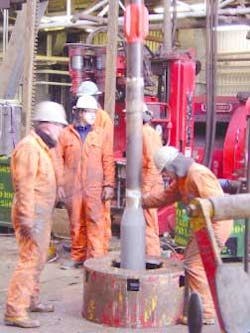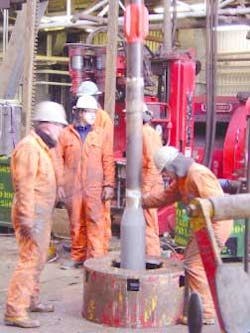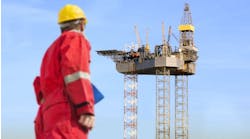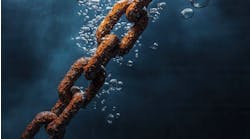Hydrocarbon-absorbing packers
Downhole packers that expand by absorbing hydrocarbons have allowed two offshore operators to produce from wells that would have not otherwise been feasible either technically or economically, according to the developer of the product.
The packers, which use hydrocarbons to expand an elastomer downhole, were invented by a Norwegian engineer, Rune Freyer, who began marketing them in 2001. According to Freyer, the packer is simple in construction, easy to apply, has no moving parts, and requires no service tools or surface activation to set it.
Freyer says the packers consist of a standard oilfield tubular with an elastomer bonded along the length of the tubular. Any number of packers are made up in the completion or casing string and deployed in a single trip into the well.
Upon contact with hydrocarbons from the reservoir, oil-based mud, or a spotted fluid, the bonded rubber swells to form a seal either inside the casing or against the open hole. The process works by the introduction of hydrocarbon molecules into the molecular structure of the rubber, allowing it to swell and stretch. According to the packer’s marketer, Easy Well, which was recently acquired by Halliburton Energy Services Inc., the simplicity of the design and application allows operators to change their approach to well construction and zonal isolation.
Shell’s application
Shell used the packer in the UK sector of the North Sea on its North Cormorant field in 2004. The challenge for the asset team to assure future production was to find ways to drill cheaper wells to exploit smaller pockets of reserves.
The team felt that by introducing a series of technologies over a six well program, they could achieve a 25% reduction in drilling costs. The key technology was through-tube rotary drilling. The important aspect was that the savings needed to be judged over the total job, not just on one single well.
A strategy was developed where the easiest wells would be tackled first and the more complex wells later. New technology was introduced to see the challenges in advance and go through the learning curve necessary to deal with them.
With the first well (CN24s2), the bottom hole assembly from the coiled tubing clean-out string got stuck and wasn’t recoverable. Solids debris from the cementing operation coupled with low annular clearances, not normally associated with conventional wells, caused the problem. The second well also ended up at a higher cost than anticipated due to cement plug issues.
The zonal isolation strategy had to be redesigned to simplify well construction and reduce the risk profile. The hydrocarbon-absorbing packers are reported to offer better zonal isolation in a small hole size, which can result in greater oil production.
A set of packers chosen for the hole size were tested to determine their applicability. They worked exceptionally well and eliminated cementing completely, according to the company. This eliminated the need to clean up cement and perforations.
The application of a phased introduction of the packers was made possible through an active service provider cooperation. Drilling time was reduced from 40 days for the first well to 20 days in the last well, with a potential to achieve 12-day wells. This reduction in time can cut costs to $2.5 million per well and recover oil that would have been uneconomical to pursue.
The asset team planned to use the packers in conjunction with a formation isolation valve (FIV) on the CN39s3 well to deliver a cost-effective completion. However, The team recognized that they needed a simpler way to run under-balanced to take full advantage. If they could achieve that goal, they could realized cost savings in the order of $1.7 million per well.
By incorporating a formation isolation valve in the completion, the team could still used the packers with their advantages. The first well experienced a pressure kick that was greater than the pressure prognosis and outside the design criteria for the well. The mud weight gradient required to kill the well was almost the same as the rock strength. The fluid dynamics (ECD) involved in a conventional cementation would have resulted in total loss of fluid returns and non-isolation of the high-pressure water interval had these packers not been included.
In this case, the well would have been lost with water flow completely dominating production. Redesigning the production liner allowed the use of these packers to isolate the high pressure water zone. Since recovery of $8.5 million worth of reserves from the well could be achieved, the partner well (CN10) was drilled according to plan.
BP’s application
BP has also used the absorbing packers in its Andrew field in the North Sea. The challenge in the Andrew reservoir was an extensive water zone in the middle of the field. Plans were to drill two sidetrack wells and isolate the water zone from the heel and toe of the reservoir. Drilling needed to be an economical operation that eliminated expensive conventional cementing and perforating.
On the first of two wells, BP used a pre-drilled liner in the pay zones with five 5.6-in. x 3m packers built on 4.5-in. base pipe to isolate the water zone. The asset team ran the liner in oil-based mud with a formation isolation valve to isolate the packers while they set and seal up against the formation face. The first well has been producing 10,000 b/d of water-free oil with 300 to 400 psi differential pressure between the water zone and the pay zones.




